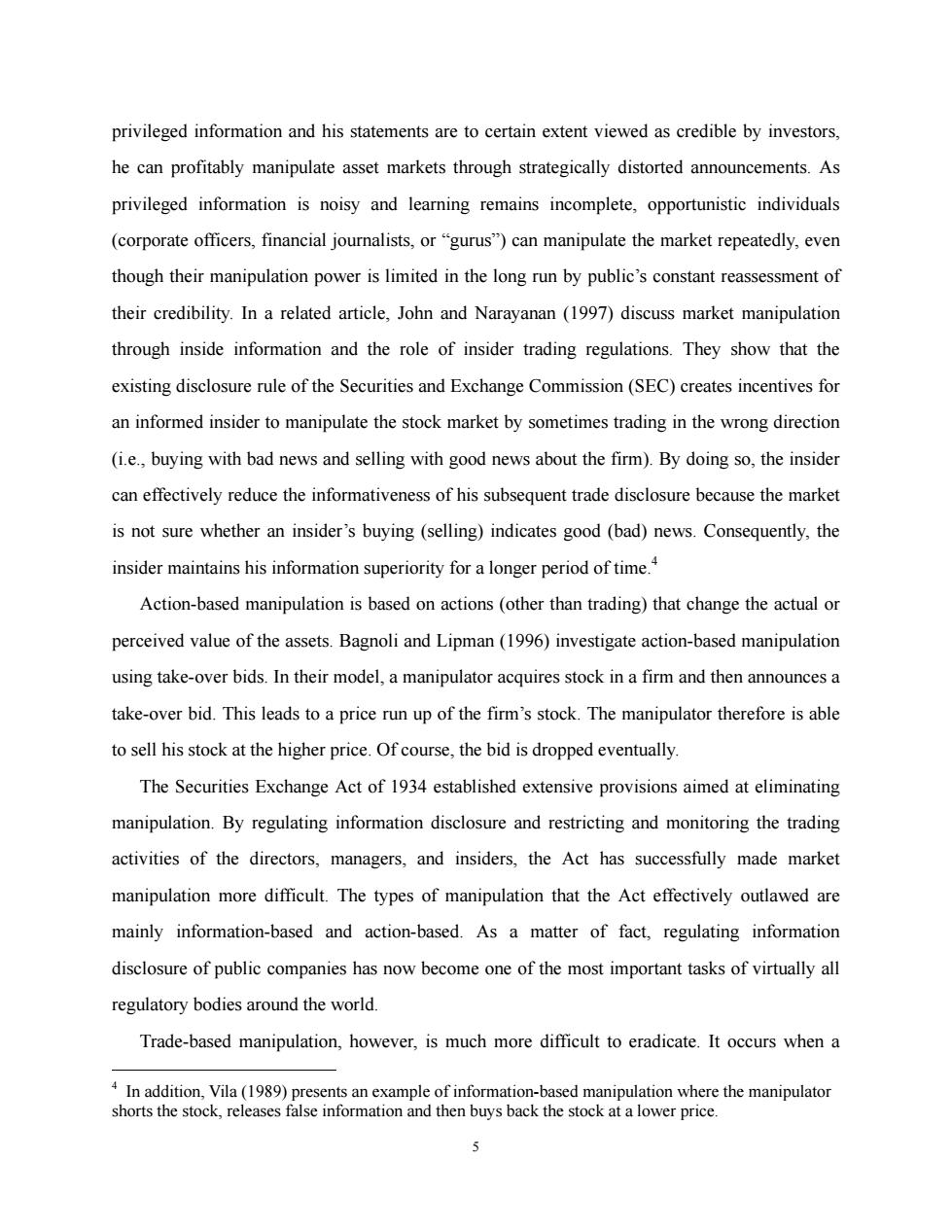正在加载图片...

privileged information and his statements are to certain extent viewed as credible by investors, he can profitably manipulate asset markets through strategically distorted announcements.As privileged information is noisy and learning remains incomplete,opportunistic individuals (corporate officers,financial journalists,or "gurus")can manipulate the market repeatedly,even though their manipulation power is limited in the long run by public's constant reassessment of their credibility.In a related article,John and Narayanan (1997)discuss market manipulation through inside information and the role of insider trading regulations.They show that the existing disclosure rule of the Securities and Exchange Commission(SEC)creates incentives for an informed insider to manipulate the stock market by sometimes trading in the wrong direction (i.e.,buying with bad news and selling with good news about the firm).By doing so,the insider can effectively reduce the informativeness of his subsequent trade disclosure because the market is not sure whether an insider's buying (selling)indicates good (bad)news.Consequently,the insider maintains his information superiority for a longer period of time. Action-based manipulation is based on actions (other than trading)that change the actual or perceived value of the assets.Bagnoli and Lipman(1996)investigate action-based manipulation using take-over bids.In their model,a manipulator acquires stock in a firm and then announces a take-over bid.This leads to a price run up of the firm's stock.The manipulator therefore is able to sell his stock at the higher price.Of course,the bid is dropped eventually The Securities Exchange Act of 1934 established extensive provisions aimed at eliminating manipulation.By regulating information disclosure and restricting and monitoring the trading activities of the directors,managers,and insiders,the Act has successfully made market manipulation more difficult.The types of manipulation that the Act effectively outlawed are mainly information-based and action-based.As a matter of fact,regulating information disclosure of public companies has now become one of the most important tasks of virtually all regulatory bodies around the world. Trade-based manipulation,however,is much more difficult to eradicate.It occurs when a 4In addition,Vila(1989)presents an example of information-based manipulation where the manipulator shorts the stock,releases false information and then buys back the stock at a lower price. 55 privileged information and his statements are to certain extent viewed as credible by investors, he can profitably manipulate asset markets through strategically distorted announcements. As privileged information is noisy and learning remains incomplete, opportunistic individuals (corporate officers, financial journalists, or “gurus”) can manipulate the market repeatedly, even though their manipulation power is limited in the long run by public’s constant reassessment of their credibility. In a related article, John and Narayanan (1997) discuss market manipulation through inside information and the role of insider trading regulations. They show that the existing disclosure rule of the Securities and Exchange Commission (SEC) creates incentives for an informed insider to manipulate the stock market by sometimes trading in the wrong direction (i.e., buying with bad news and selling with good news about the firm). By doing so, the insider can effectively reduce the informativeness of his subsequent trade disclosure because the market is not sure whether an insider’s buying (selling) indicates good (bad) news. Consequently, the insider maintains his information superiority for a longer period of time.4 Action-based manipulation is based on actions (other than trading) that change the actual or perceived value of the assets. Bagnoli and Lipman (1996) investigate action-based manipulation using take-over bids. In their model, a manipulator acquires stock in a firm and then announces a take-over bid. This leads to a price run up of the firm’s stock. The manipulator therefore is able to sell his stock at the higher price. Of course, the bid is dropped eventually. The Securities Exchange Act of 1934 established extensive provisions aimed at eliminating manipulation. By regulating information disclosure and restricting and monitoring the trading activities of the directors, managers, and insiders, the Act has successfully made market manipulation more difficult. The types of manipulation that the Act effectively outlawed are mainly information-based and action-based. As a matter of fact, regulating information disclosure of public companies has now become one of the most important tasks of virtually all regulatory bodies around the world. Trade-based manipulation, however, is much more difficult to eradicate. It occurs when a 4 In addition, Vila (1989) presents an example of information-based manipulation where the manipulator shorts the stock, releases false information and then buys back the stock at a lower price